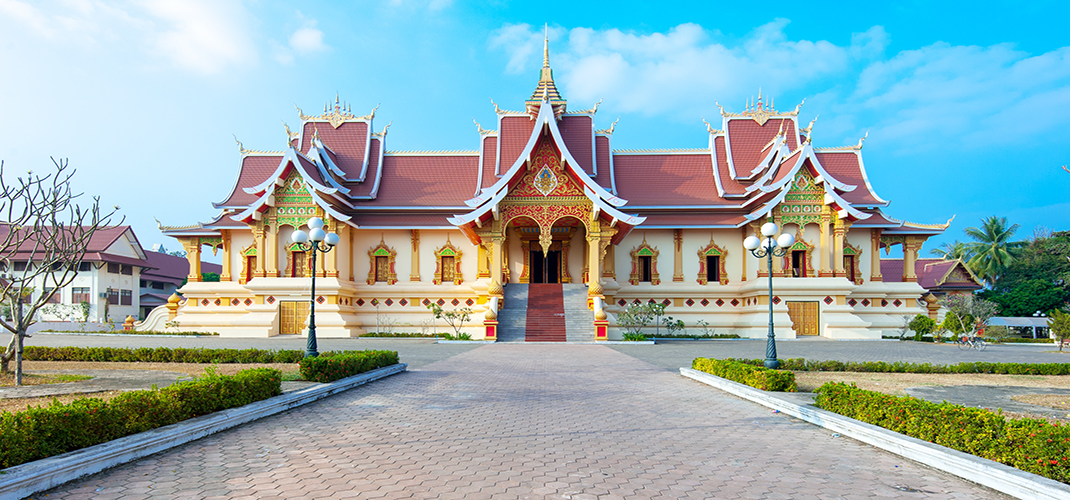Laos

Present day Laos traces its historic and cultural identity to the kingdom of Lan Xang Hom Khao (Kingdom of a Million Elephants under the White Parasol). Today, Laos offers truly authentic experiences in a country of friendly and hospitable people. Around three quarters of Laos is made up of mountains and plateaus in the North and Southeast. Northern Laos is dominated by rough mountains, jungles and agricultural areas. The plain region is located along the Mekong River and forms the other quarter of the country.
Visiting ethnic minority Hilltop Villages is a fascinating experience and an opportunity to observe their culture. The northern provinces of Bokeo, Luang Namtha and Pongsali have the most diverse collection of ethnic minority. The country’s ethnic diversity is the main reason why handicrafts, livelihood systems, traditional clothing, rituals and house sizes and design vary in Laos. The most commonly visited ethnic villages in the country are the Akha, Khmu, Yao, Lanten and Hmong. When visiting ethnic villages, tourists are requested to show courtesy and respect to tribes’ culture.
Vientiane, capital of Laos, also known as the 'City of the Sandalwood' is situated along the curve of Mekong River. This city offers a laid back way of life with less modern infrastructures presenting a relaxing cosy feeling. One of the most prominent landmarks is the Patuxai or Victory Monument, situated on Lang Xang Avenue which resembles Paris’ Arc de Triomphe with the top of the monument offering panoramic views over the city. Other attractions not to be missed include the Presidential Palace, Vat Si Saket considered to be the oldest surviving temple and housing 6840 Buddha statues and figures and Ho Phra Keo, popularly known as the former Temple of Emerald Buddha. Situated on the eastern outskirts of the city, Pha That Luang is also known as the Great Stupa and only 24 kms south of Vientiane is the Buddha Park or Xieng Khun, a park filled with large concrete statues of deities from Hindu-Buddhist pantheon and Buddha images including the 40 metre reclining Buddha.
The town of Luang Prabang is an exquisite ancient town situated in northern Laos. The town was declared as UNESCO World Heritage Site in 1995 and is an exceptional illustration of the fusion of traditional architecture and Lao urban structures with arrays of fine French colonial buildings built in the 19th and 20th Century. This tranquil city serves as home to hundreds of golden robe monks, countless ancient Temples and well preserved colonial houses. Luang Prabang colourful night market displays a huge selection of locally produced handicrafts. There are fourteen significant ancient Temples including the most impressive and historically significant Vat Xieng Thong, one of the oldest in Laos, dating back to the 16th Century. Other significant attractions include Vat Mai, the Royal Palace Museum also known as Ancient National Museum and Mt. Phousi, a Holy Mountain right at the centre of the old town. There are 328 stairs to reach the summit, which will offer you a 360 degree view over Luang Prabang, Mekong River, Nam Khan and the surrounding countryside.
Lying along the banks of the Mekong River, Savannakhet is the most populous province in the country. This small town resembles a small French town with comparable structures surrounding a central market place. The main tourist attractions in the area are the Temples. About 15 kms north of the city along the Seno Road lays the second most revered religious place in southern Laos, That Ing Hang Temple, a very sacred site for Laotian Buddhist after Wat Phou ruins in Champassak. Another impressive site is the 1000 year old ancient Khmer Empire ruins of Vat Heuan Hin, “Temple House Made of Stones”. Also in the town of Savannakhet is Vat Sayaphoum, one of the largest and most historic Temples, housing more than 200 monks and novices.
Luang Namtha is a mountainous region in the north western part of the country. Luang Namtha Museum is a good place to get oriented to the province’s rich culture and natural resources before exploring the city. The museum exhibits a significant collection of indigenous clothing and artefacts, currency from colonial times, religious artefacts, agricultural tools, weapons as well as Khmu bronze drums. Handicrafts co-operatives exist to provide livelihood to the villagers. The Black Tai village is known for their production and weaving of silks while Akha women produce traditional silver jewellery, beaded necklaces and bracelets, the Hmong women sell embroidery, bags and clothing the and Lanten ethnic group produces bamboo paper, indigo clothing and carved objects. There are also a number of Temples and ruins within the area including Vat Luang Kim, Khou Vieng and Vat Mahapot.
Plain of Jars is an intriguing archaeological site situated midway between Vientiane and Luang Prabang, lying in a mountainous limestone karst area of Xieng Khouang Province. Plain of Jars has a bizarre collection of mysterious antique stone jars scattered across the war scarred countryside. The jars are presumed to be one of the oldest archaeological sites in Southeast Asia. Some jars are made from sandstone, granite, conglomerate while others are made from limestone. A number of sites contain more than 250 jars. These jars weigh about 14 tons and their height ranges from 1 to 3 metres.
Filter Results
Trip Duration
Price Range
Country Destinations
Select Countries to Visit
City Destinations
Select Cities to Visit
Tour Categories
Select a Tour Category
Filter Results
Trip Duration
Price Range
Country Destinations
Select Countries to Visit
City Destinations
Select Cities to Visit
Tour Categories
Select a Tour Category
